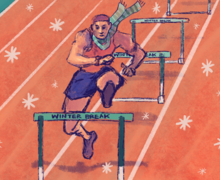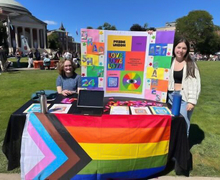Chemical bonds: Rob Doyle’s team of students unites in effort to cure cancer, diabetes
The first thing that hits is the smell. It’s overwhelming in Rob Doyle’s chemistry laboratory on the second floor of Syracuse University’s Science and Technology Center – the harsh scent of alcohol, deep and thick.
Then there’s the noise, the throb of the different refrigerators and incubators, the whirr of the magnetic stirrers, the little hisses and beeps emitted from the different testing machinery.
Those inside, however, don’t seem to notice. It’s a hub of activity as Doyle’s students buzz around, running tests, carrying coolers, checking computer printouts.
Doyle, assistant professor of chemistry at SU, and his team of students are on the cutting edge of developments in cancer and diabetes treatment. Doyle is new at SU, a native of Ireland who studied at Dublin’s Trinity College before coming to Yale University in 2003. He came to SU last year and now has 10 students at his disposal, six graduates and four undergraduates.
The group develops other projects as well, like those dealing with magnetic materials or the study of the environmental uptake of heavy metals such as mercury and lead.
In less than a year, Doyle’s group already submitted research that could help revolutionize the treatment of cancer by using transition metals such as folic acid to carry the drug AZT directly into cancer cells. The drug usually combats HIV and generally is considered too harmful for cancer patients.
‘It’s like a Trojan horse,’ Doyle said.
They have also developed a patent for oral insulin, so diabetes patients don’t have to inject themselves with needles for treatment, he said.
This lab is where it all starts. It’s like a second home for the graduate students. They’re in the lab more than 40 hours during the week and usually about 10 on the weekends.
‘I spend most of my time here because this is what we’re here for,’ said Tayo Ikuton, a second-year graduate student.
They generally teach some sort of introductory course, such as chemistry 107 or chemistry 139, for university stipends, but research is more important, said Amanda Petrus, another second-year graduate student.
‘We’ve got a steep learning curve here,’ Doyle said. ‘You’ve got to learn all the techniques, but you’ve also got to produce results.’
They spend so much time in the lab that they have to like each other, Petrus said. It makes work easier.
‘It’s great when you get along, but it’s torture if you don’t,’ she said.
Doyle keeps the mood light in the lab, whether it’s by cracking jokes about saving diabetic San Diego Padres pitcher David Wells or performing impromptu demonstrations. When Petrus comes by with a jar of dry ice, Doyle, eyes gleaming, scoops up a handful and tosses it into a jar of water to watch it foam up. Stylish and clean-cut, his head is shaved bald, a thin wisp of red stubble traced around his mouth.
‘They’re going to spend their whole time trying to convince you it won’t work,’ Doyle said to Nerissa Viola, second-year graduate student, after Viola came seeking his help. ‘So you have to have answers for their questions.’
It’s not as simple as developing a chemical compound and then testing it, Petrus said. They have to make sure the compounds are uniform and they know their chemical compositions.
The testing, however, can be tedious, even when they leave the lab.
Late in the afternoon one day last week, Viola tests some of the AZT compounds on the State University of New York College of Environmental Science and Forestry campus, using ESF’s Matrix-assisted laser desorption ionization (MALDI) machinery.
‘It’s nice to get out of the lab once in a while,’ Villegas says quietly as she leaves Sci-Tech.
Drums and shouts from an Iraq war protest echo through the Quad, but Viola doesn’t seem to notice. Head down, she talks about how the MALDI works, how it will analyze the compounds and assess their mass. They do this to make sure all of the compounds they create are uniform and pure, Viola said.
Viola preps the compounds for the MALDI on the third floor of the Jahn Laboratory at ESF, mixing a catalyst with compounds that another grad student, Tony Vortherms, has been working on.
Using a micropipette to drop little bits of catalyst solution into the compound, she then transfers them into the little divots of a tiny metal pan.
It’s a long process. Viola is careful, meticulous, her massive syringe gently clicking each time it inhales or exhales solution.
The MALDI, off-white and box-shaped, spits out a small metal tongue on which Viola places the pan, a computer connected to its left. The interior of the machine pops and hisses as it takes it in.
A laser in the MALDI is applied to the solution by an old gray joystick. The laser activates the solution so the mass can be observed.
After the first try, which is a white flash that goes off on the old Hitachi TV zoomed in on the plate, Viola can’t find anything on the computer screen, no chart spike to indicate the compound’s mass.
‘I’ll blast them again; I’m not seeing it,’ she says.
This time, it works. The reading is faint; Viola has to zoom in on the computer to see it, but it’s there. It’s off, though, she says, not what they wanted. Maybe the compound they’re testing wasn’t constructed correctly; maybe it’s just not what they’re looking for.
But it’s not a dead-end. It just means back to the lab for more research, more testing.
Back to the alcohol stench and the drone of refrigerators, back to the lab.
Published on April 16, 2007 at 12:00 pm





